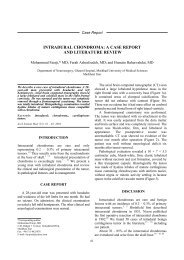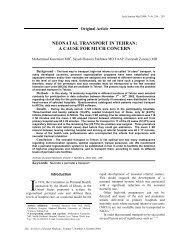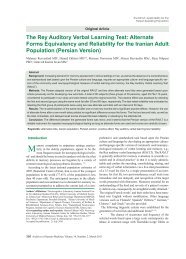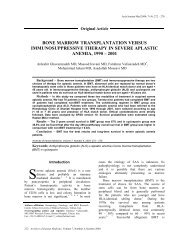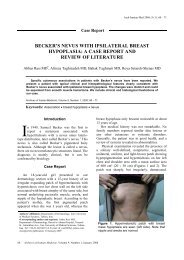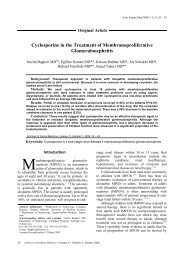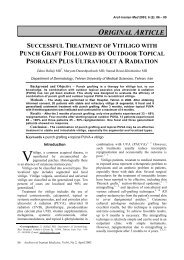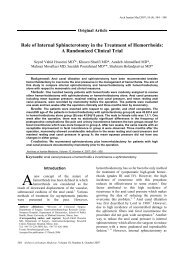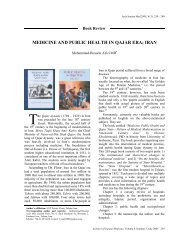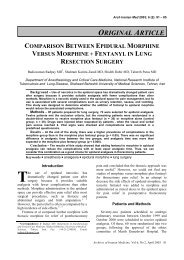Isaac's Syndrome Associated with CIDP and Pregnancy
Isaac's Syndrome Associated with CIDP and Pregnancy
Isaac's Syndrome Associated with CIDP and Pregnancy
Create successful ePaper yourself
Turn your PDF publications into a flip-book with our unique Google optimized e-Paper software.
Introduction<br />
N<br />
euromyotonia <strong>with</strong> all its synonyms is a paradoxical entity,<br />
in part because of its remarkable clinical pleomorphism,<br />
uncertain natural history <strong>and</strong> anecdotal response to<br />
an assortment of treatments. 1 It is a disorder of peripheral nerve<br />
hyperexcitability characterized by regular or irregular myokymia,<br />
muscle cramps <strong>and</strong> stiffness, delayed muscle relaxation after contraction<br />
(pseudomyotonia), <strong>and</strong> hyperhidrosis associated <strong>with</strong><br />
well described spontaneous electromyographic features. Neuromyotonia<br />
is usually an acquired immuno-mediated disorder occurring<br />
in isolated form or associated to autoimmune diseases,<br />
such as myasthenia gravis. 2–6<br />
Herein, we report clinical <strong>and</strong> electrodiagnostic �ndings of a<br />
pregnant woman <strong>with</strong> neuromyotonia who, after further investigations<br />
was diagnosed <strong>with</strong> chronic in�ammatory demyelinating<br />
polyneuropathy (<strong>CIDP</strong>).<br />
Case Report<br />
A 24-year-old female patient referred to our electrodiagnosis<br />
laboratory for evaluation of muscle cramps. Previously, the impression<br />
of myotonia congenita had been proposed for her.<br />
She was a young, alert, slender lady <strong>with</strong> chief complaints of<br />
severe cramps in her arms <strong>and</strong> legs. Gait was extremely stiff <strong>and</strong><br />
laborious <strong>with</strong> super�cial similarity to the movements of reptiles<br />
(armadillo gait). The symptoms appeared nine months before during<br />
the fourth month of her pregnancy <strong>with</strong> myokymia, muscle<br />
cramps <strong>and</strong> night sweats. Four months before, she had delivered<br />
a healthy boy through normal vaginal delivery <strong>with</strong>out any complications.<br />
She had severe cramps <strong>and</strong> stiffness in all four limbs,<br />
most noticeably in the legs. Muscle stiffness were persisted during<br />
sleep. She had been prescribed phenytoin <strong>and</strong> carbamazepine in<br />
the last nine months, which were ineffective to relieve her symp-<br />
206 Archives of Iranian Medicine, Volume 14, Number 3, May 2011<br />
Case Report<br />
Isaac’s <strong>Syndrome</strong> <strong>Associated</strong> <strong>with</strong> <strong>CIDP</strong> <strong>and</strong> <strong>Pregnancy</strong><br />
Keivan Basiri MD •1 , Farzad Fatehi MD 2 , Ahmad Chitsaz MD 3<br />
Abstract<br />
Neuromyotonia <strong>with</strong> all its synonyms is a disorder of peripheral nerve hyperexcitability characterized by regular or irregular myokymia,<br />
muscle cramps <strong>and</strong> stiffness, delayed muscle relaxation after contraction, <strong>and</strong> hyperhidrosis associated <strong>with</strong> well-described spontaneous<br />
electromyographic features. Herein, we report clinical <strong>and</strong> electrodiagnostic �ndings of a pregnant woman <strong>with</strong> neuromyotonia who also<br />
suffered from chronic in�ammatory demyelinating polyneuropathy. We treated the patient <strong>with</strong> plasma exchange, 50 mL/kg (twice weekly,<br />
for six weeks). After two weeks of treatment, cramps <strong>and</strong> stiffness were substantially reduced. After four weeks, she looked normal <strong>with</strong> a<br />
relatively smooth gait. After eight weeks, the patient was entirely well <strong>with</strong> no cramps or stiffness. Repeat EMG showed no myokymic discharges.<br />
After four months she was in good health <strong>and</strong> the plasma exchanges continued every other week <strong>with</strong>out the use of corticosteroids<br />
or cytotoxic agents. Afterwards, we discontinued the plasma exchange <strong>and</strong> only visited the patient regularly. One year later, we repeated a<br />
�ve-day course of plasma exchange to overcome mild recurrence of myokymia in her thighs. Now, after four years, she is healthy <strong>with</strong>out<br />
any disability or problem. The patient’s child has been healthy throughout <strong>with</strong>out any evidence of neuromyotonia.<br />
Keywords: chronic in�ammatory demyelinating polyneuropathy, Isaac’s syndrome, neuromyotonia, pregnancy<br />
Authors’ af�liations: 1,3 Department of Neurology, Isfahan Neuroscience Research<br />
Center, Isfahan University of Medical Sciences, Isfahan, Iran. 2 Departemnt<br />
of Neurology, Shariati Hospital, Tehran University of Medical Sciences,<br />
Tehran, Iran.<br />
•Corresponding author <strong>and</strong> reprints: Keivan Basiri MD, Alzahra hospital,<br />
Sofeh Street, Isfahan, Iran. Tel: +98-913-329-0713, Email: basiri@med.mui.ac.ir<br />
Accepted for publication: 13 October 2010<br />
Isaac’s <strong>Syndrome</strong> <strong>and</strong> <strong>CIDP</strong><br />
toms; however, the symptoms had progressed relentlessly <strong>and</strong><br />
generated a great disability.<br />
The patient did not report any history of fever, chills, joint pain,<br />
<strong>and</strong> rash. There was no history of toxic exposures <strong>and</strong> she had<br />
been completely healthy before the pregnancy. General examination<br />
including skin, respiratory, cardiovascular, gastrointestinal,<br />
<strong>and</strong> urinary systems was also normal. On neurological examination,<br />
she was alert <strong>and</strong> oriented <strong>with</strong> intact cranial nerves. On motor<br />
examination, there was reduced bulk <strong>and</strong> atrophy in all four<br />
limbs; in addition, accurate estimation of strength was not possible<br />
because of severe cramps <strong>and</strong> stiffness in all four limbs. She<br />
had diffuse myokymia, especially in the lower limbs. On sensory<br />
examination, loss of pain, temperature, <strong>and</strong> vibration were detected<br />
in the distal parts of all four limbs. She exhibited reduced deep<br />
tendon re�exes (grade 1) at the biceps, triceps, <strong>and</strong> brachioradialis<br />
on both sides. Likewise, the deep tendon re�exes were absent on<br />
both knees <strong>and</strong> ankles, bilaterally. Plantar re�ex was also �exor on<br />
both sides <strong>and</strong> cerebellar tests were normal as well.<br />
In electrodiagnostic studies (EDX) all sensory <strong>and</strong> motor nerve<br />
conduction velocities (NCVs) were reduced <strong>and</strong> conduction block<br />
was detected in most of the examined motor nerves (Table 1).<br />
In electromyography, there were detectable diffuse fasciculation<br />
potentials in all four limbs associated <strong>with</strong> continuous motor unit<br />
activity (CMUA) <strong>and</strong> bursts of motor unit potentials along <strong>with</strong><br />
intraburst frequencies of 40 – 100 HZ.<br />
Frozen <strong>and</strong> paraf�n embedded sections of nerve biopsy from the<br />
sural nerve revealed demyelination <strong>and</strong> mild epineural, endoneural<br />
<strong>and</strong> perivascular in�ltration of lymphocytes <strong>with</strong>out evidence<br />
of �brinoid necrosis. On CSF examination, there was evidence of<br />
increased protein (93 mg/dL) in the cerebrospinal �uid <strong>with</strong> no<br />
increase in the number of white blood cells (albuminocytologic<br />
dissociation).<br />
With the possible impression of neuromyotonia, an immunoprecipitation<br />
assay applying alpha dendrotoxin was used for detection<br />
of anti-VGKC antibody, which was positive [titer=684 Pico<br />
moles (pM); titer greater than 100 pM was considered positive].<br />
The laboratory tests for vasculitis including anti-nuclear antibody,<br />
anti-double str<strong>and</strong> DNA, anti-phospholipid antibody, anticardiolipin<br />
antibody <strong>and</strong> LE-cell were negative. No evidence of<br />
thymoma or lung cancer was found on thoracic CT scan. Ace-
Nerves<br />
Motor nerves<br />
Sensory<br />
nerves<br />
tylcholine receptor antibody <strong>and</strong> test for thyroglobulin antibody<br />
were negative. Total abdominal sonography detected no lymph<br />
node enlargement.<br />
She was treated <strong>with</strong> plasma exchange of 50 cc/kg, twice weekly<br />
for six weeks. After two weeks of treatment, cramps <strong>and</strong> stiffness<br />
relieved radically. After four weeks, she looked normal <strong>with</strong><br />
a relatively smooth gait.<br />
Repetition of the nerve conduction study revealed improvement<br />
of nerve conduction velocities in both sensory <strong>and</strong> motor nerves<br />
(Table 1) <strong>and</strong> profound decrease of CMUA. Myokymic discharges<br />
overshadowed by CMUA in a previous study were apparent.<br />
After eight weeks, the patient was entirely well <strong>with</strong> no cramps<br />
or stiffness. On the third EMG, there were no myokymic discharges<br />
noted. After four months, she was in good health; the plasma<br />
exchanges were administered every other week <strong>with</strong>out the use of<br />
corticosteroids or cytotoxic agents. Afterwards, we discontinued<br />
the plasma exchange <strong>and</strong> only visited the patient regularly. One<br />
year later, we repeated a �ve-day course of plasma exchange to<br />
overcome mild recurrence of myokymia in her thighs. Currently,<br />
after four years, she is healthy <strong>with</strong>out any disability or problem.<br />
The patient’s child has continual follow up visits by a pediatric<br />
neurologist; he is also healthy <strong>with</strong>out any evidence of neuromyotonia.<br />
Discussion<br />
Table 1. Motor <strong>and</strong> sensory nerve conduction studies of the patient before <strong>and</strong> after plasma exchange (PE).<br />
Latency (ms)<br />
After<br />
Before PE<br />
PE<br />
Amplitude (mv)<br />
Before PE After PE<br />
NCV (m/s)<br />
After<br />
Before PE<br />
PE<br />
Proximal amplitude<br />
decrement (%)*<br />
Before PE After PE<br />
Rt median 4.8 4.4 4.3 4.4 33 38 74 60<br />
Lt median 4.4 4.3 4.9 4.9 35 40 52 41<br />
Rt ulnar 4.1 3.8 5.2 5.4 31 39 65 52<br />
Lt ulnar 3.9 3.6 4.8 4.9 28 32 66 48<br />
Lt tibial 7.1 7.0 2.9 2.9 24 29 45 42<br />
Rt tibial 8.3 7.9 2.8 2.9 27 30 38 33<br />
Lt peroneal 6.9 6.8 2.1 2.4 30 33 77 51<br />
Rt peroneal 7.7 7.2 2.3 2.5 31 34 63 53<br />
Our patient is the �rst instance of Isaac’s syndrome associated<br />
<strong>with</strong> <strong>CIDP</strong> during the pregnancy that terminated in normal<br />
vaginal delivery of a live, healthy boy. This case is unique from<br />
several aspects: i) this is the �rst instance of Isaac’s syndrome associated<br />
<strong>with</strong> <strong>CIDP</strong> that initiated during pregnancy; ii) pregnancy<br />
continued for about �ve months <strong>with</strong>out any complications, thus<br />
neuromyotonia may not have adverse effects on the course of<br />
pregnancy; iii) vaginal delivery was uneventful <strong>with</strong>out complications;<br />
<strong>and</strong> iv) �nally, after three years of follow up, the patient’s<br />
son is completely healthy <strong>with</strong> no signs of neuromyotonia found<br />
in repeated visits, which suggests that anti-VGKC antibodies may<br />
not pass through the placenta.<br />
Isaac’s syndrome has been postulated to be an autoimmune channelopathy,<br />
probably by affecting voltage gated potassium channels<br />
(VGKC) leading to excitation <strong>and</strong> abnormal discharges. 7–10<br />
It is signi�cant that the patient’s plasma or IgG can transfer the<br />
electrophysiological features to mice <strong>and</strong> reduce VGKC currents<br />
K. Basiri, F. Fatehi, A. Chitsaz<br />
Rt median 3.9 3.7 8.4 10.8 38 39<br />
Lt ulnar 4.4 4.1 10.9 12.4 33 35<br />
Lt sural 6.4 5.8 6.2 7.1 29 31<br />
*Conduction block=proximal amplitude decrement of more than 50% in comparison <strong>with</strong> distal part. Rt=right; Lt=left; ms=millisecond; mv=millivolts; m/<br />
s=meter per second; NCV=nerve conduction velocity.<br />
in vitro. 11 Spontaneous discharges seem to be mostly generated at<br />
sites distal to the terminal axon branching points. 12<br />
Most patients present <strong>with</strong> muscle cramps, delayed relaxation,<br />
muscle hypertrophy, increased sweating, slowly progressive<br />
weakness, muscle spasms <strong>and</strong> stiffness, fasciculations, <strong>and</strong><br />
myokymia. 13,14 Our patient also presented <strong>with</strong> cramps, stiffness,<br />
sweating, <strong>and</strong> myokymia. Isaac’s syndrome occurs most often<br />
as a paraneoplastic syndrome in patients <strong>with</strong> cancers of the immune<br />
system, such as lymphoma <strong>and</strong> thymoma. 6,15 It is also associated<br />
<strong>with</strong> other immune mediated diseases, including systemic<br />
lupus erythematosus, myasthenia gravis, Hashimoto’s thyroiditis,<br />
dermatomyositis 7,8,16,17 <strong>and</strong> chronic hepatitis B infection. 18 Peripheral<br />
neuropathy is sometimes present <strong>and</strong> some reports describe<br />
the association of neuromyotonia <strong>and</strong> neuropathy. 6,7,19–23 Recently,<br />
other associated disorders noted are chronic obstructive pulmonary<br />
disease, episodic ataxia <strong>and</strong> congenital heart disease. 16,24,25<br />
Nerve conduction studies are usually normal, 13 but may be slowed<br />
due to accompanying peripheral neuropathy. 26 Hyperexcitability<br />
of the nerves, demonstrated by repetitive discharges which follows<br />
M-wave, are occasionally observed 27 <strong>and</strong> high amplitude,<br />
long duration, <strong>and</strong> polyphasic F-waves after either tibial nerve or<br />
peroneal nerve stimulation have been described. 28 Needle EMG<br />
shows continuous motor unit activity at rest <strong>with</strong> bursts of rapid-<br />
�ring discharges <strong>and</strong> myokymic discharges which are unaffected<br />
by spinal anesthesia but diminished by peripheral nerve block <strong>and</strong><br />
completely abolished by local curarization. 13,14 Muscle biopsy may<br />
show type two-�ber atrophy 13 <strong>and</strong> nerve biopsy may be normal or<br />
show evidence of axonal degeneration <strong>and</strong> demyelination. 6,14<br />
Muscle cramping, twitching <strong>and</strong> stiffness are usually responsive<br />
to phenytoin <strong>and</strong> carbamazepine. 13,14 Most patients show moderate<br />
to marked response to plasma exchange. 7,15,28 Response to<br />
prednisone <strong>and</strong> azathioprine has also been mentioned. 14<br />
In our patient, all the above mentioned secondary causes were<br />
ruled out by appropriate tests. Only peripheral neuropathy was<br />
detected in the form of <strong>CIDP</strong>. It is noticeable that only one case<br />
of <strong>CIDP</strong> associated <strong>with</strong> Isaac’s syndrome has been reported in<br />
the literature. 14 The exact mechanism provoking excess muscle<br />
activity in acquired neuropathy is not de�ned, but the activity is<br />
believed to originate in the peripheral nerves at the sites of focal<br />
demyelination. Factors that could contribute to the generation of<br />
CMUA at the sites of focal demyelination include alteration in sodium<br />
<strong>and</strong> potassium currents, change in the composition of the extracellular<br />
�uid, <strong>and</strong> stretch-sensitive ion channels at the sites. 29,30<br />
Archives of Iranian Medicine, Volume 14, Number 3, May 2011 207
References<br />
1. Panagariya A, Kumar H, Mathew V, Sharma B. Neuromyotonia: clinical<br />
pro�le of twenty cases from northwest India. Neurol India. 2006; 54: 382<br />
– 386.<br />
2. Falace A, Striano P, Manganelli F, Coppola A, Striano S, Minetti C, et al.<br />
Inherited neuromyotonia: a clinical <strong>and</strong> genetic study of a family. Neuromuscul<br />
Disord. 2007; 17: 23 – 27.<br />
3. Arimura K, Sonoda Y, Watanabe O, Nagado T, Kurono A, Tomimitsu H,<br />
et al. Isaacs’ syndrome as a potassium channelopathy of the nerve. Muscle<br />
Nerve. 2002; Suppl 11: S55 – S58.<br />
4. Newsom-Davis J, Mills KR. Immunological associations of acquired neuromyotonia<br />
(Isaacs’ syndrome). Report of �ve cases <strong>and</strong> literature review.<br />
Brain. 1993; 116 (Pt 2): 453 – 469.<br />
5. Gutmann L, Gutmann L. Myokymia <strong>and</strong> neuromyotonia 2004. J Neurol.<br />
2004; 251: 138 – 142.<br />
6. Lahrmann H, Albrecht G, Drlicek M, Oberndorfer S, Urbanits S, Wanschitz<br />
J, et al. Acquired neuromyotonia <strong>and</strong> peripheral neuropathy in a patient<br />
<strong>with</strong> Hodgkin’s disease. Muscle Nerve. 2001; 24: 834 – 838.<br />
7. Hayat GR, Kulkantrakorn K, Campbell WW, Giuliani MJ. Neuromyotonia:<br />
autoimmune pathogenesis <strong>and</strong> response to immune modulating therapy.<br />
J Neurol Sci. 2000; 181: 38 – 43.<br />
8. Taylor PW. Isaacs’ syndrome (autoimmune neuromyotonia) in a patient<br />
<strong>with</strong> systemic lupus erythematosus. J Rheumatol. 2005; 32: 757 – 758.<br />
9. Arimura K. Isaacs’ syndrome, stiff person syndrome <strong>and</strong> Satoyoshi disease:<br />
pathomechanisms <strong>and</strong> treatment. Rinsho Shinkeigaku. 2004; 44: 805<br />
– 807.<br />
10. Tomimitsu H, Arimura K, Nagado T, Watanabe O, Otsuka R, Kurono A,<br />
et al. Mechanism of action of voltage-gated K+ channel antibodies in acquired<br />
neuromyotonia. Ann Neurol. 2004; 56: 440 – 444.<br />
11. Newsom-Davis J. Neuromyotonia. Rev Neurol (Paris). 2004; 160: S85<br />
– S89.<br />
12. Arimura K, Arimura Y, Ng A, Uehara A, Nakae M, Osame M, et al. The<br />
origin of spontaneous discharges in acquired neuromyotonia. A Macro<br />
EMG study. Clin Neurophysiol. 2005; 116: 1835 – 1839.<br />
13. Scola RH, Comerlato EA, Teive HA, Germiniani F, Werneck LC. Isaacs’<br />
syndrome. Report of three cases. Arq Neuropsiquiatr. 1999; 57: 267 – 272.<br />
14. Odabasi Z, Joy JL, Claussen GC, Herrera GA, Oh SJ. Isaacs’ syndrome<br />
associated <strong>with</strong> chronic in�ammatory demyelinating polyneuropathy.<br />
Muscle Nerve. 1996; 19: 210 – 215.<br />
15. Viallard JF, Vincent A, Moreau JF, Parrens M, Pellegrin JL, Ellie E. Thymoma-associated<br />
neuromyotonia <strong>with</strong> antibodies against voltage-gated<br />
potassium channels presenting as chronic intestinal pseudo-obstruction.<br />
Eur Neurol. 2005; 53: 60 – 63.<br />
208 Archives of Iranian Medicine, Volume 14, Number 3, May 2011<br />
Isaac’s <strong>Syndrome</strong> <strong>and</strong> <strong>CIDP</strong><br />
16. Morgan PJ. Peripartum management of a patient <strong>with</strong> Isaacs’ syndrome.<br />
Can J Anaesth. 1997; 44: 1174 – 1177.<br />
17. Oh SJ, Alapati A, Claussen GC, Vernino S. Myokymia, neuromyotonia,<br />
dermatomyositis, <strong>and</strong> voltage-gated K+ channel antibodies. Muscle Nerve.<br />
2003; 27: 757 – 760.<br />
18. Basiri K, Fatehi F. Isaacs syndrome associated <strong>with</strong> chronic hepatitis B<br />
infection: a case report. Neuroi Neurochir Pol. 2009; 43: 388 – 390.<br />
19. Toepfer M, Schroeder M, Unger JW, Lochmuller H, Pongratz D, Muller-<br />
Felber W. Neuromyotonia, myocloni, sensory neuropathy <strong>and</strong> cerebellar<br />
symptoms in a patient <strong>with</strong> antibodies to neuronal nucleoproteins (anti-<br />
Hu-antibodies). Clin Neurol Neurosurg. 1999; 101: 207 – 209.<br />
20. Torbergsen T, Stalberg E, Brautaset NJ. Generator sites for spontaneous<br />
activity in neuromyotonia. An EMG study. Electroencephalogr Clin Neurophysiol.<br />
1996; 101: 69 – 78.<br />
21. Martinelli P, Patuelli A, Minardi C, Cau A, Riviera AM, Dal Pozzo F. Neuromyotonia,<br />
peripheral neuropathy <strong>and</strong> myasthenia gravis. Muscle Nerve.<br />
1996; 19: 505 – 510.<br />
22. Perini M, Ghezzi A, Basso PF, Montanini R. Association of neuromyotonia<br />
<strong>with</strong> peripheral neuropathy, myasthenia gravis <strong>and</strong> thymoma: a case<br />
report. Ital J Neurol Sci. 1994; 15: 307 – 310.<br />
23. Hahn AF, Parkes AW, Bolton CF, Stewart SA. Neuromyotonia in hereditary<br />
motor neuropathy. J Neurol Neurosurg Psychiatry. 1991; 54: 230 –<br />
235.<br />
24. Jamora RD, Umapathi T, Tan LC. Finger �exion resembling focal dystonia<br />
in Isaacs’ syndrome. Parkinsonism Relat Disord. 2006; 12: 61 – 63.<br />
25. Victor M, Ropper AH. Disorders of muscle characterized by cramp,<br />
spasm, pain, <strong>and</strong> localized masses. In: Victor M, Ropper AH, eds. Principles<br />
of Neurology. New York: McGraw-Hill; 2001: 1566 – 1576.<br />
26. Hart IK, Maddison P, Newsom-Davis J, Vincent A, Mills KR. Phenotypic<br />
variants of autoimmune peripheral nerve hyperexcitability. Brain. 2002;<br />
125: 1887 – 1895.<br />
27. Yamaguchi K, Komori T, Hirose K, Tanabe H. Clinical analysis of the<br />
complex repetitive discharge following M wave. Rinsho Shinkeigaku.<br />
1995; 35: 908 – 910.<br />
28. Tanosaki M, Baba M, Miura H, Matsunaga M, Arimura K. Reversible Fwave<br />
hyperexcitability associated <strong>with</strong> antibodies to potassium channels in<br />
Isaacs’ syndrome. Eur J Neurol. 1999; 6: 95 – 98.<br />
29. Meriggioli MN, S<strong>and</strong>ers DB. Conduction block <strong>and</strong> continuous motor unit<br />
activity in chronic acquired demyelinating polyneuropathy. Muscle Nerve.<br />
1999; 22: 532 – 537.<br />
30. Smith KJ, Felts PA, Kapoor R. Axonal hyperexcitability: mechanisms <strong>and</strong><br />
role in symptom production in demyelinating diseases (Review). Neuroscientist.<br />
1997; 3: 237 – 246.



